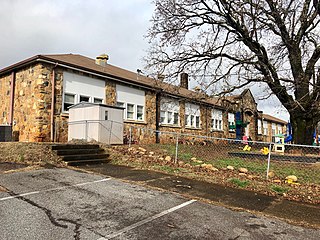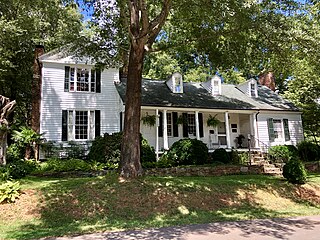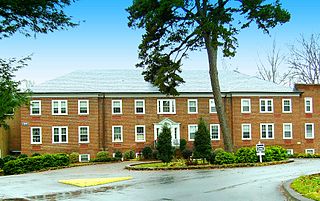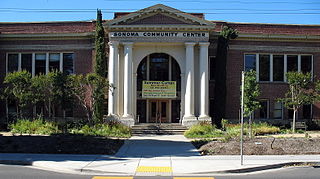
Camp Randall is an historic U.S. Army site in Madison, Wisconsin, named after Wisconsin governor Alexander Randall, who served from 1858 to 1861. It was a training facility of the Union army during the Civil War, where more than 70,000 recruits were trained. The army also established a hospital and prisoner-of-war camp here.

Biddle Memorial Hall is a historic building located on the campus of Johnson C. Smith University in Charlotte, Mecklenburg County, North Carolina. It was built in 1883, and is a 3 1/2-story, five bay Romanesque style brick and stone building on a raised basement. It features an elaborate clock tower with a pyramidal slate roof and baritizans at each corner. It was built as the main building for the school established in 1867 by the Presbyterian church for the education of African-American students. It was named in 1923 to honor Mary D. Biddle who donated $1,400 to the school.

The Webster Rock School is an historic school building located NC 116 / Main St., at Webster, Jackson County, North Carolina. It was built between 1936 and 1938 by the Works Progress Administration, and is one story with hip roof utilitarian building, constructed of native "river rock" in colors of tan and brown. It has an "E"-shape plan and has a 13 bay front facade. The school originally contained an auditorium, cafeteria, kitchen and eight classrooms.

The Greensboro History Museum, consisting of the former First Presbyterian Church of Greensboro and Smith Memorial Building, is a historic museum building located at 130 Summit Ave. in Greensboro, Guilford County, North Carolina. The former Presbyterian church was built in 1892, and is a Romanesque Revival style brick building with a cross gable roof and tower. The semi-circular, 11 bay, Smith Memorial Building was built in 1903. It features four octagonal sides and a tower. The memorial building was designed by the architect Charles Christian Hook (1870-1938). The church and memorial building were connected and the older structures modified and renovated in 1938. Also located on the property is the First Presbyterian Church cemetery, established in 1831, after the first church was built on land that was donated by Jesse H. Lindsay. The church vacated the property in 1929, and in 1937-1938 it was renovated and enlarged as the Richardson Civic Center and donated to the city of Greensboro. It subsequently housed the Greensboro Public Library, the Greensboro Historical Museum, and the Greensboro Art Center. The historic building functions as one part of the current, larger Greenboro History Museum.

Tingley Memorial Hall is a historic academic building located on the campus of Claflin University at Orangeburg, Orangeburg County, South Carolina. It was built in 1908, and is a two-story, brick Classical Revival style building. The hipped and gable roof is topped by an octagonal cupola. The buildings serves as the main building on the Claflin College campus.

Kerr Scott Farm, also known as Melville, is a historic home and farm located near Haw River, Alamance County, North Carolina. The vernacular farmhouse was built in 1919, and consists of a 1 1/2-story, frame, center hall plan, hip-roofed main block, with a one-story frame gable-roofed ell built about 1860. The property includes a variety of contributing outbuildings including a farm office, milk house, woodshed, dairy barns, equipment building / machine shop (1941), cow shed, gas / oil house, corn crib (1910), silos, and cow sheds. It was the home of North Carolina governor and United States Senator, W. Kerr Scott (1896-1958) and the birthplace of W. Kerr Scott's son, also a former North Carolina governor, Robert W. Scott.

Schoenberger Hall was a historic residential building located at Asheville, Buncombe County, North Carolina. It was built in 1987, and was a 2 1/2-story, brick dwelling. It featured an Eastlake-detailed wraparound verandah and a slate-shingled mansard roof. The building was the former home of the Ravenscroft Associate Missions and Training School of the North Carolina Episcopal Diocese and the former residence of the Bishop of the Episcopal Diocese of Western North Carolina. The building has been demolished.

Biltmore Hospital, also known as the Biltmore Hospital Extension and Memorial Mission Hospital, is a historic hospital building located at Biltmore Village, Asheville, Buncombe County, North Carolina. It was built in 1929-1930, and originally known as the Battle Wing to the Clarence Barker Memorial Hospital. It is a four-story, 13 bay by 3 bay, brick and stone building with a flat roof and Tudor Revival style design elements. A two-story wing was completed in 1953 for the Imperial Life Insurance Company. Also on the property are contributing culverts and a sign.

Caffeys Inlet Lifesaving Station is a historic lifesaving station located near Duck, Dare County, North Carolina. It was built in 1897-1898 by the United States Life-Saving Service near the location of Caffey's Inlet, a historic inlet that opened in 1770 and closed in 1811. It is a two-story, Shingle Style rectangular frame building with a hipped roof lookout tower. It has hip roofed porches connected by a shed roof porch. It was one of seven lifesaving stations established on the Outer Banks of North Carolina in 1874, to serve the ships that were lost in the treacherous waters off the North Carolina coast.

Cana Store and Post Office is a historic general store and post office building located near Mocksville, Davie County, North Carolina. It was built about 1875, and is a two-story, three bay, frame building with a gable roof. The front facade features a broad hip-roofed frame canopy added in the 1930s, that serves as a "porte cochere." Also on the property is a contributing one-story woodshed built in the 1930s. The building housed a post office until 1954 and a general store until 1965.

W. F. Smith and Sons Leaf House and Brown Brothers Company Building, also known as Piedmont Leaf Tobacco Co., is a historic tobacco manufacturing complex located at Winston-Salem, Forsyth County, North Carolina. The complex includes two buildings. The W. F. Smith and Sons Leaf House was built about 1890, and is a 4 1/2-story, nine bays long and three bays wide, stuccoed brick building with a stepped gable facade. The former Brown Brothers building, was built between 1890 and 1895, and is a five-story brick building with a mansard roof and hip roof dormer windows. By 1900 both buildings housed tobacco prizeries.

Mars Hill Baptist Church, also known as Fries Memorial Moravian Church, is a historic African-American Baptist church located at Winston-Salem, Forsyth County, North Carolina. It was built in 1915, and is a "T"-shaped brick building with corner tower in the Gothic Revival style. Also on the property is the parsonage; a one-story, pebble-dash finished Queen Anne style dwelling. It has a high hipped roof, a central hipped dormer, and a hipped-roof full-front porch supported by fluted columns. It was originally built for a white Moravian congregation, until the Mars Hill Baptist Church congregation purchased the building in 1944 for $4,000.

Boone-Withers House is a historic home located at Waynesville, Haywood County, North Carolina. It was built about 1883, and is a 2 1/2-story, Late Victorian style frame dwelling. It has a large, two-story gabled wing and three smaller, two-story bays. It features a one-story, hip roofed wraparound porch and two tall chimneys.

Carolina Transfer and Storage Company Building is a historic warehouse building located at Charlotte, Mecklenburg County, North Carolina, United States. It was built in 1927, and is a four-story, flat-slab construction building with brick infill. The building has a flat roof and parapet.

Crane Company Building is a historic warehouse building located at Charlotte, Mecklenburg County, North Carolina. It was built in 1928, and is a two-story, reinforced concrete building. The building has a flat roof with parapet, brick curtain walls and steel window frames and stairs.

Heartsease is a historic home located at Hillsborough, Orange County, North Carolina. It was built about 1820, and consists of a 1 1/2-story, three-bay, central block dating to the late 18th century, with an early 19th-century 1 1/2-story east wing, and two-story pedimented west wing added in the late 19th century. It is topped by a gable roof and features a shed porch whose roof supported by plain Tuscan order posts. It is believed that Heartsease served as the pre-Revolutionary home of Thomas Burke, North Carolina's third governor and a member of the Constitutional Convention.

Granite Quarry School, also known as Schuford Memorial Elementary School and Granite Quarry Elementary School, is a historic school complex located at Granite Quarry, Rowan County, North Carolina. The main school building was built in 1933, and is a one-story, "H"-shaped building sheathed in granite. It has a side gable roof with shed dormers and a pedimented entrance portico. Connected to the main building by open, covered walkways are the cafeteria (1956) designed by Leslie Boney and a classroom building (1960). It was originally built for African-American students and continued to operate until 1968 when its students were integrated into other county schools.

Randle House, also known as the Randall House, is a historic plantation house located near Norwood, Stanly County, North Carolina. It was built about 1835, and is a two-story, transitional Federal / Greek Revival style frame I-house dwelling. It is sheathed in weatherboard and has a gable roof. It has a gable roofed ell and attached kitchen/dining building. The front facade features a hipped roof porch.

Hugh Chatham Memorial Hospital is a historic hospital building located near Elkin, Surry County, North Carolina. The original rectangular section was built in 1930–1931, with additions made in 1937, 1947, and 1952. The original brick section is two stories over a partially above-ground basement in the Colonial Revival style/ It is eleven bays long and two rooms deep, with a slate-covered hipped roof with a central cupola and two rear dormers. The associated Nurses' Home was built in 1932, and is a two-story-with-basement rectangular brick building in the Colonial Revival style. Frame side wings were added to Nurses' Home in 1937. The hospital was converted to a nursing home and interior remodeled in 1973.

Harry Fitzhugh Lee House is a historic home located at Goldsboro, Wayne County, North Carolina. It was built in 1922, and is a two-story, five bay, Colonial Revival style brick dwelling with a gambrel roof and frame shed-roof dormers. A 1 1/2-story gambrel roofed addition was built in 1939. It features a covered porch supported by paired Doric order pillars. It was the home of Harry Fitzhugh Lee, a prominent Goldsboro businessman and a great-nephew of General Robert E. Lee.





















